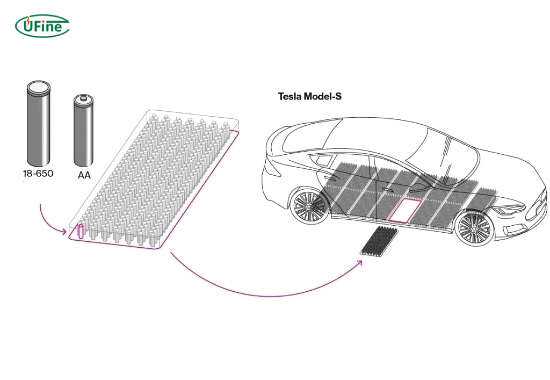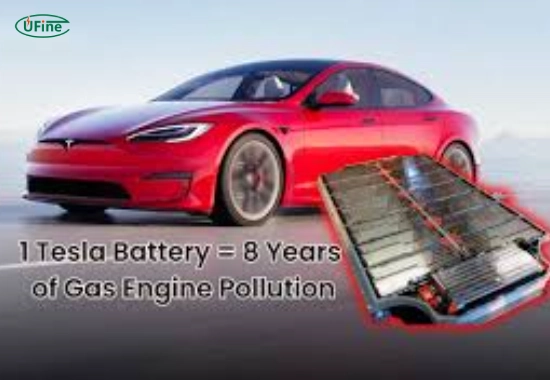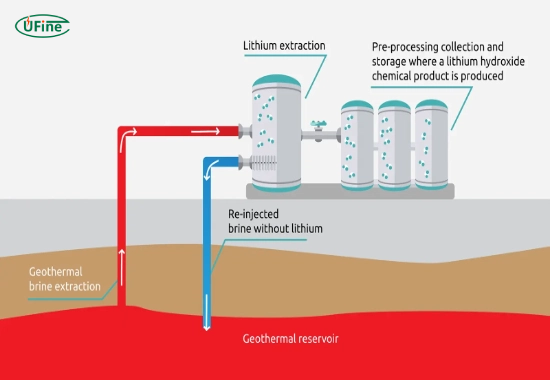As the world shifts toward renewable energy and sustainable solutions, electric vehicles (EVs) have taken center stage in the fight against climate change. Tesla, a pioneer in the EV industry, has been at the forefront of this movement. However, concerns about the environmental impact of Tesla batteries – specifically their production, usage, and disposal – have sparked heated debates. Are Tesla batteries genuinely sustainable, or do they come with hidden environmental costs?
In this article, we’ll examine the environmental implications of Tesla batteries in depth. We’ll explore their lifecycle, their role in reducing carbon emissions, and whether their benefits outweigh their drawbacks. By the end, you’ll have a clearer understanding of whether Tesla batteries are as eco-friendly as they are often portrayed.
Part 1. What are Tesla batteries made of?
Tesla batteries are primarily lithium-ion batteries, the same type found in smartphones, laptops, and many other electronic devices. These batteries consist of several key components:
- Lithium: A lightweight and highly reactive metal.
- Nickel: Used to increase energy density and improve battery lifespan.
- Cobalt: Helps stabilize the battery and prevent overheating.
- Graphite: Used as the anode material.
- Electrolytes: Facilitate the flow of ions between the battery’s cathode and anode.
These materials are essential for creating high-performance, long-lasting batteries, but their extraction and processing have significant environmental implications. Critics often point to the energy-intensive mining processes and the potential harm to ecosystems as drawbacks of Tesla batteries.
Part 2. How environmentally friendly is lithium mining?
One of the significant environmental concerns associated with Tesla batteries is lithium mining. Lithium is a critical component of Tesla’s batteries, and its extraction has raised several red flags:
- Water usage: Lithium mining requires vast water, particularly in arid regions. For example, in South America’s “lithium triangle” (Argentina, Chile, and Bolivia), mining operations consume millions of liters of water daily, leading to water scarcity for local communities.
- Habitat destruction: Mining operations can disrupt ecosystems and threaten wildlife habitats.
- Energy consumption: Extracting and refining lithium is an energy-intensive process, often reliant on fossil fuels, contributing to greenhouse gas emissions.
While Tesla commits to sourcing materials responsibly, people cannot ignore the environmental impact of lithium mining.
Part 3. Do Tesla batteries reduce carbon emissions?
The short answer is yes but with caveats. Tesla batteries significantly reduce carbon emissions during the use phase of electric vehicles compared to traditional internal combustion engine (ICE) vehicles. Here’s how:
- Zero tailpipe emissions: Tesla vehicles produce no emissions while driving, unlike ICE vehicles that emit CO2 and other pollutants.
- Lower lifetime emissions: Studies show that even when accounting for battery production, EVs have a lower carbon footprint over their lifetime than gasoline-powered cars.
However, the environmental benefits depend on how Tesla generates the electricity to charge its batteries. The carbon savings are substantial if the electricity comes from renewable sources like wind or solar. However, the grid diminishes the environmental benefits if it relies heavily on coal or natural gas.
Part 4. What happens to Tesla batteries at the end of their life?
Another critical question is the fate of Tesla batteries once they reach the end of their useful life. Improper disposal of lithium-ion batteries can lead to:
- Toxic waste: Batteries contain hazardous materials like cobalt and nickel, which can leach into the soil and water if not properly managed.
- Fire risks: Old batteries can pose fire hazards due to their high energy density.
Tesla has implemented battery recycling programs to address these concerns. The company claims that it designs its batteries to be 100% recyclable, recovering valuable materials like lithium and nickel for reuse. While this is a step in the right direction, the recycling process is still energy-intensive and has room for improvement.
How Likely Combustable Is Tesla 4680 Battery?
Part 5. Are Tesla’s cobalt concerns justified?
Tesla uses cobalt as a key ingredient in its batteries, but critics have condemned its extraction for:
- Human rights violations: Cobalt mining, particularly in the Democratic Republic of Congo, has been linked to child labor and unsafe working conditions.
- Environmental degradation: Cobalt mining can lead to deforestation, soil erosion, and water pollution.
To mitigate these issues, Tesla has been working to reduce its reliance on cobalt by developing nickel-rich battery chemistries and exploring alternative materials. While these efforts are promising, the transition away from cobalt is still ongoing.
Part 6. How does Tesla compare to other EV manufacturers?
When evaluating the environmental impact of Tesla batteries, it’s essential to compare Tesla’s practices to those of other EV manufacturers. Tesla has taken several steps to minimize its ecological footprint:
- Sustainable sourcing: Tesla claims to source materials ethically and responsibly.
- Battery innovation: Tesla’s battery technology is among the most efficient and long-lasting in the industry.
- Recycling initiatives: Tesla is investing in closed-loop recycling systems to recover materials from old batteries.
While no EV manufacturer is perfect, many see Tesla as a leader in automotive sustainability efforts.
Part 7. What is Tesla’s role in renewable energy storage?
Beyond EVs, Tesla batteries play a crucial role in renewable energy storage. Products like the Tesla Powerwall and Megapack let homeowners and businesses store solar energy during non-sunny hours. This reduces reliance on fossil fuels and promotes the adoption of renewable energy.
By integrating battery storage with renewable energy systems, Tesla is helping to create a more sustainable energy grid.
Part 8. What are the alternatives to Tesla batteries?
As concerns about the environmental impact of lithium-ion batteries grow, researchers are exploring alternative technologies, such as:
- Solid-state batteries: These batteries promise higher energy density, faster charging, and improved safety, but they are still in the experimental stage.
- Sodium-ion batteries: These batteries, made from abundant materials like sodium, could be a more sustainable alternative to lithium-ion batteries.
- Hydrogen fuel cells: While not directly competing with Tesla batteries, hydrogen fuel cells offer a zero-emission alternative for specific applications.
While these alternatives promise, Tesla’s lithium-ion batteries remain the most practical and widely available option.
Part 9. Can Tesla batteries support a circular economy?
A circular economy aims to minimize waste by reusing and recycling materials. Tesla’s commitment to battery recycling aligns with this goal. By recovering valuable materials from old batteries, Tesla can reduce the need for new mining operations and lower the overall environmental impact. However, achieving a fully circular economy will require advancements in recycling technology and more significant investment in infrastructure.
Part 10. Are Tesla batteries genuinely sustainable?
The question of sustainability is complex. While Tesla batteries have undeniable environmental benefits – such as reducing tailpipe emissions and enabling renewable energy storage – their production and disposal still pose challenges. The key to improving their sustainability lies in the following:
- Ethical sourcing of raw materials.
- Advancements in recycling technologies.
- Transitioning to renewable energy for both battery production and vehicle charging.
Tesla is making strides in these areas, but it still needs to do more work.
Part 11. FAQs
-
Do Tesla batteries pollute the environment?
Tesla batteries reduce pollution during their use phase. Still, their production and disposal have environmental impacts, such as mining-related habitat destruction and waste management challenges. -
How long do Tesla batteries last?
Tesla designs its batteries to last 300,000 to 500,000 miles, or roughly 10-20 years, depending on usage and maintenance. -
Can Tesla batteries be recycled?
Yes, Tesla has developed recycling programs to recover valuable materials like lithium and nickel from old batteries. However, the recycling process is still energy-intensive. -
Are there alternatives to lithium-ion batteries?
Researchers are exploring alternatives like solid-state batteries, sodium-ion batteries, and hydrogen fuel cells, but they are not yet widely available. -
How does Tesla ensure ethical sourcing of materials?
Tesla works with suppliers to ensure ethical sourcing and has reduced its reliance on cobalt, a material often linked to human rights violations.
Related Tags:
More Articles

How to Choose the Best Floor Scrubber Battery for Commercial Cleaning?
Selecting the ideal floor scrubber battery ensures a long runtime, rapid charging, and minimal maintenance for efficient commercial cleaning operations.
Battery for Blower vs Battery for Leaf Vacuum: Which One Should You Choose?
Battery for blower vs leaf vacuum—learn the key differences in power, fit, and runtime to choose the right battery for your outdoor tool needs.
How to Choose the Right Battery for Blower?
Choosing the right blower battery? Consider voltage, capacity, chemistry & usage. This guide helps match the best battery for peak performance.
How to Choose the Best Insulated Battery Box for Lithium Batteries?
Choosing the Best Insulated Battery Box for Lithium Batteries? Discover key factors such as size, material, and safety for optimal protection and performance.
7 Critical Elements on a Lithium Battery Shipping Label
What must be on a lithium battery shipping label? Learn 7 key elements to ensure safety, legal compliance, and correct handling across all transport modes.






